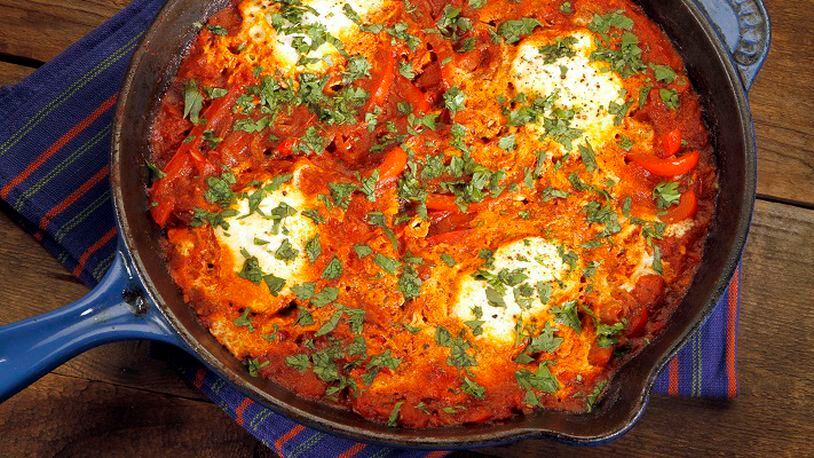Maybe the dish’s ascendancy can be traced to cookbook author Yotam Ottolenghi. In his bestselling “Jerusalem” and “Plenty” tomes, the Israeli-born London chef prominently features shakshuka recipes.
Or perhaps it’s the influence of much-heralded American chefs — including Michael Solomonov in Philadelphia and Alon Shaya in New Orleans — and the rising familiarity of their modern Israeli cooking, boosted by their cookbooks.
In the end, it doesn’t really matter. Shakshuka, which is basically eggs poached in a peppery tomato stew, is delicious, and it’s here to stay.
You know those days when you come home from a gruesome day at work, and you end up calling scrambled eggs “dinner”?
This is when shakshuka is totally your friend, because it has the appearance that you’ve fussed, but the effort you’re actually investing is minimal. Don’t forget to keep shakshuka in your brunch back pocket, because it’s one of those centerpiece recipes that never fails to impress.
An easy stovetop meal, shakshuka (also spelled shakshouka) comes together in a flash. It requires a little chopping, some simmering and a round of egg-cracking. Thirty or so minutes, and you’re eating.
I rely on the recipe in Solomonov’s James Beard award-winning “Zahav: A World of Israeli Cooking” (Rux Martin/Houghton Mifflin Harcourt, 2015), because it calls for ingredients that I usually have on hand. Another plus is the way it ramps up the paprika, cumin and garlic, ensuring that the outcome will be more lively than other recipes I’ve considered.
It also cooks completely on the stovetop. Some shakshuka recipes start on the stove, then the pan goes into the oven to cook the eggs, but that’s a hassle. Besides, in the summer months — and yes, you’ll want to serve shakshuka year-round — who wants to heat up the kitchen by turning on the oven?
Shakshuka is also remarkably flexible. The “Zahav” recipe doesn’t include feta. To me, that’s a mistake, so I add about 1/2 cup crumbled feta. Sometimes it goes in at the end, just before the cilantro. Other times, I follow the advice of Melissa Clark from the New York Times, and add the feta just before cracking the eggs; the heat of the pan turns the cheese soft and creamy.
Want to make it spicier? Add a tablespoon or two of harissa. Don’t have red bell peppers? Use their green cousins. No cilantro? Flat-leaf parsley or mint will do. Instead of sugar, consider honey. Crushed caraway seeds are a fragrant replacement for coriander. For a nutritional boost, stir in a cup of chopped kale or Swiss chard before adding the eggs.
If there are no canned crushed tomatoes in the pantry, make your own. In a food processor fitted with a metal blade, purée roughly 1 1/2 of those 28-ounce cans of whole peeled tomatoes, to yield approximately 4 cups puree. I prefer canned tomatoes over fresh, because using the latter adds another 15 to 20 minutes to the cooking process, and shakshuka is all about saving time.
Another tip: The sauce can be prepared in advance, and refrigerated until you’re ready to eat. Just reheat until the sauce is bubbling, then add the eggs.
Shakshuka originated in Tunisia, and spread across North Africa to the Middle East. In “Zahav,” Solomonov theorizes that its universal popularity in Israel is driven by economics.
“Tomatoes and peppers grow year-round in Israel, and eggs are an inexpensive source of protein,” he writes. “Shakshouka became an economical way to create a nutritious and flavorful meal.”
And a meal it is. Serve with crusty bread or pita.
Here’s how to make shakshuka:
Shakshuka
Serves 4.
Note: Adapted from “Zahav: A World of Israeli Cooking,” by Michael Solomonov and Steven Cook.
— 1/2 cup olive oil, divided
— 1 onion, chopped (about 1 1/2 cup)
— 2 red bell peppers, cored, seeded and chopped into 1/4-inch dice
— 3 garlic cloves, sliced
— 3 tablespoon sweet paprika
— 1 teaspoon ground cumin
— 1 tsp. ground coriander
— 1/2 teaspoon kosher salt
— 4 cups crushed tomatoes
— 2 teaspoon sugar
— 8 eggs
— Serrano chiles, thinly sliced
— Freshly chopped cilantro, for garnish
Directions
Heat 2 tablespoons olive oil over medium heat in a large skillet. Add the onions, bell peppers, garlic, paprika, cumin, coriander and salt, and cook, stirring occasionally, until the vegetables have softened but not browned, about 10 minutes.
Add crushed tomatoes and sugar and simmer until reduced by about one-third, 10 to 12 minutes. Whisk in the remaining 2 tablespoons olive oil.
Crack the eggs in the skillet, spacing them evenly in the sauce. Reduce heat to low, cover and cook until the egg whites are set but the yolks remain runny, about 5 minutes. Top with serrano chiles and cilantro and serve immediately, right from the pan.
About the Author
